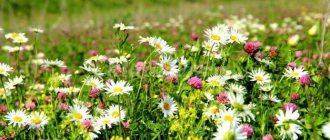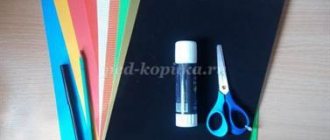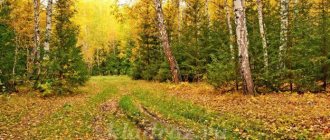Summary of GCD in the middle group “Beautiful Flowers”
GCD for drawing “Beautiful Flowers”
Target:
Teach children to draw flowers, conveying in the drawing the structure of the flower (stem, leaves, petals) and using various techniques: brushing in different directions, drawing round and oval shapes. Strengthen the ability to paint with the entire bristle and end of the brush. Develop observation skills, the ability to perceive the beauty of the surrounding world; cultivate a sense of compassion, evoke a desire to help the game characters.
There is a knock on the window. A butterfly flies in.
Educator: “Look, guys, a butterfly has flown to us. She is so scared and frozen. Dear butterfly, what happened?
Project “There are different flowers” Middle group 2021
Project “There are different flowers” Middle group 2021
Project “Flowers are different” Middle group
Objective of the project:
introducing children to the variety of flowers, their structure, the conditions necessary for their growth, and the impact on a person’s emotional state.
Objectives of this project:
Expanding and clarifying children’s ideas about flowering plants and their diversity;
Reinforce concepts: indoor, garden, meadow, medicinal plants.
Develop a caring attitude towards plants, develop a desire to care for them.
To cultivate a love for beauty, the beauty of the world around us.
Develop children's creative abilities, consolidate the ability to reflect received impressions in drawings and creative works.
Involve parents in project activities.
Relevance:
The beauty of flowers is undeniable; they are beautiful at any time of the year. Flowers are one of the eternal symbols of goodness - a miracle that is created by human hands and the bright scorching sun, which allows plants to grow in the ground.
In modern conditions, the problem of environmental education of preschool children becomes particularly acute and relevant. It is during the period of preschool childhood that the formation of the human personality and the formation of the beginnings of ecological culture take place. Therefore, it is very important to awaken children’s interest in living nature, cultivate a love for it, and teach them to take care of the world around them.
It is very important to instill in our children a responsible attitude towards nature; it is necessary to make educational work invisible and attractive to children, through cartoons, educational games, physical exercises, poetry, listening to music, looking at pictures of flowers, etc.
The theme of the project was not chosen by chance, because flowers surround us all year round, bringing joy to everyone. Their aroma is wonderful, and there are a great many types of flowers.
Flowers are not only beauty, but also a part of living nature that must be protected and protected, and, of course, known. Know the structure of a flower, its appearance, features, healing properties.
Anyone can pick a flower, but not everyone can say what flower they picked and why.
Project type
: cognitive - research, creative, collective.
By nature of content
: child and nature
Project participants:
children 4-5 years old (middle group) and a teacher.
By duration
: short-term (2 weeks).
Main forms of project implementation:
Gaming activities: didactic, environmental, board and other games.
Children's experimentation (experiments, observations, research).
Artistic and creative activities of children and parents of pupils (application, herbarium and making an album about flowers).
Summary of GCD for drawing in the middle group “Beautiful Flowers”
Daria Rimshan
Summary of GCD for drawing in the middle group “Beautiful Flowers”
Abstract of GCD for HER ( drawing )
in
the middle group
on the topic: “ Beautiful flowers ”
.
Goal: to consolidate children’s ideas about flowers (their structure, classification, develop the ability to draw flowers , using different techniques and unconventional forms of drawing (crumpled paper)
.
1. Continue to form children’s understanding of flowers , their structure, classification, teach children to draw flowers using non-traditional forms ( drawing with crumpled paper )
;
2. Continue to develop the ability to draw with different techniques (painting in different directions, drawing with the whole bristle and the end of the brush) and techniques ( drawing with crumpled paper , develop aesthetic feelings (children should carefully choose the color of paint , imagination, creativity;
Summer fun in the middle group of kindergarten. Journey to the Land of Flowers
Integrated lesson for children of middle preschool age. Synopsis “Journey to the Land of Flowers”
Author:
Victoria Aleksandrovna Ostanina, teacher of the MDOU DS KV "Raduga" JV "Silver Hoof"
Description of the material:
I offer you a summary of an integrated lesson for children of middle preschool age.
This educational activity will allow children to consolidate their knowledge about wildflowers, their value for humans and teach them to see the beauty around them. Goal:
creating conditions for the development of children's cognitive interest.
Objectives:
- fixing the names of wild and wild flowers, their medicinal properties;
- consolidation of knowledge of the colors of the rainbow; — development of memory, imagination and imaginative thinking of children; - running exercise; Materials and equipment:
Gnome costume, book of fairy tales, white palette, seven colors for placement on the palette, double-sided tape, pictures of wild and forest flowers, plot pictures about not spoiling nature (in a red frame), flowers with riddles, walking path, whatman paper, finger paints, saucer, hoop, artificial flowers (according to the number of children), two baskets, small iron bells according to the number of boys, butterfly masks according to the number of girls, musical equipment, audio recording of calm music, blue ribbons 1 m. according to the number of children, balloons according to the number of children.
Preliminary work:
- Introduction to wildflowers and their beneficial and harmful properties; — Learning poems about flowers. Appendix No. 3. - Introduction to the games “Cornflower”, “Bells”
Progress of the event
The children gathered in the hall.
The hall is decorated with images of various wild flowers. A white palette hangs on the central wall. Presenter:
Hello guys.
Today we have gathered in this room to spend some time on an interesting conversation about flowers. There are a lot of beautiful flowers around our kindergarten. Your mothers and fathers, grandmothers and grandfathers helped us make our areas so bright and beautiful. This is how many flowers grow in the flower beds. Tell me guys, do flowers only grow in flower beds? Children's answers. Presenter:
Correct.
Flowers grow in fields and meadows and even in forests. What else can you call wild flowers? Children's answers. Presenter:
That's right, guys.
Wildflowers. There's a knock on the door. The presenter approaches the door, opens it, and finds an envelope on the floor. Presenter:
It’s strange, there’s no one there, only someone left a letter.
Guys, shall we read the letter? Children's answers. Presenter:
Listen guys: “Guys, I urgently need your help.
The land of flowers is in danger! Dwarf". Oh, guys, Good Uncle Dwarf needs our help. Did I tell you the story about Uncle Gnome? Children's answers. Presenter: No? Then listen. (Opens the book and reads) …….Once upon a time, a good uncle Gnome lived in the magical land of Flowers. He knew the name of each flower, carefully watched that the clouds watered all the flowers......So that the sun rose on time and warmed the flowers with its rays. The flowers answered him in kind and never ceased to delight the Dwarf with their variety and color. They sang songs to him in their unusual language and blossomed with colorful colors. The gnome loved to draw and was a wonderful dreamer, so his country had a wide variety of flowers. He painted them with his own paints and they came to life as soon as the Dwarf finished his drawing! Closes the book. Presenter:
Interesting story?
Children's answers. Presenter
(reads from the book again): Somehow, trouble happened in the Land of Flowers.
The evil wizard stole all the colors from Uncle Gnome and the flowers lost their charm and withered. The Gnome called the guys for help and they returned Uncle Gnome’s magic palette. This time there is trouble again. Guys, can we help Uncle Dwarf? Shall we return his palette? Children's answers. Presenter:
It’s so good that you are all so brave. But not simple tasks await you on the way. After all, Uncle Gnome’s palette contains seven colors of the rainbow. Name them please.
Children name the colors of the rainbow.
Presenter:
So, each of our tests will be the color of the rainbow. But to collect Uncle Gnome's palette. We need to get to the magical Land of Flowers, for this we need to close our eyes tightly and say the magic words: “Flowers - flowers, Magic leaves One, two, three, Call us to visit you!” Children close their eyes and say magic words.
Presenter:
Here we are in a magical land!
The adventure begins! Red color.
Presenter:
To get the red color for our palette......now I’ll read it in a book of fairy tales, you need to guess all the riddles about flowers.
Children solve riddles. See Appendix No. 1. Presenter:
Well done, guys, you solved all the riddles.
So we earned the color red! The presenter attaches red to the palette. Presenter:
The color ahead is orange.
Orange color.
Presenter:
To get this color, you need to work hard and collect all the flowers that grew on the lawn.
Game “Collect flowers” Materials:
hoop, artificial flowers, two baskets.
How to play:
All players are divided into two teams.
Built in 2 columns. As soon as the music starts, players take turns running up to an impromptu lawn (a hoop with flowers lying in it), take 1 flower, run back, and put it in the basket. As soon as the flowers in the meadow end, the music stops. Presenter:
Well done guys, you completed the task.
Orange is our color! The presenter attaches the color to the palette. Yellow color .
Presenter:
Guys, what yellow wildflowers do you know?
Children's answers. Presenter:
Well done, they named a lot of yellow flowers: buttercups, dandelions, tansy, St. John's wort, shepherd's purse, primrose, coltsfoot, and even chamomile, because it has two colors - white and yellow.
It is chamomile that will help us get the yellow color. We have a large chamomile, on the leaves of which you need to place pictures of medicinal plants, as soon as all the chamomile leaves are filled in without errors, you will get the desired color. Game “Chamomile” Materials:
large chamomile, table, easel, pictures of flowers (medicinal), magnets.
Progress of the game:
Children look at pictures of medicinal flowers lying on the table, and take turns naming their medicinal properties, attaching the named flower to a chamomile petal.
Presenter:
Well done guys, a lot of knowledge in your smart heads!
Get yellow. The presenter attaches yellow to the palette. Presenter:
There is green ahead.
Green color.
Presenter:
Guys, flowers cannot do without their living friends, insects.
After all, it is insects that pollinate flowers, which means they help them grow. It is insects that will help us earn green color - the color of all living things. In the magic book of fairy tales there are riddles about insects. You will have to guess them. The presenter reads riddles from the book, and the children guess them. Appendix No. 2. Presenter:
And we completed this task.
The blue color is sent to the palette. The presenter attaches blue to the palette. Blue.
Presenter:
Guys, guess the riddle: “The blue bell is hanging, It never rings.
(Bell)" Children's answers. Presenter:
That's right, it's a bell.
Let's play a game guys. Game “Bells” Materials:
Bells according to the number of boys, butterfly masks according to the number of girls, musical equipment, audio recording of calm music.
Progress of the game:
The boys hold bells in their hands and ring them, saying the words: “Blue bell, Play with me, Ring your bell for me, Modest meadow flower!”
As soon as the words end, calm music plays and butterflies flutter. The music ends and the butterfly must take the bell by the handle. If a butterfly or bell is left without a pair, it leaves the game. Presenter:
How many butterflies!
And the bells are so ringing. Get the blue you deserve. The presenter attaches the color to the palette. Blue color.
Presenter: The blue color will be given to us by a very beautiful flower called cornflower. Shows a picture. Did you guys recognize it? Children's answers. Presenter:
Listen to the story about the cornflower: The presenter opens the book and reads.
…….“Cornflower is a charming healer. There is no rye field in which graceful and cute cornflowers do not grow. They bloom from May to September. The Latin name - Centauréa - arose from the Greek adjective centaureus, that is, belonging to a centaur. The myth says that with these flowers the centaur Chiron was cured of the poison of the hydra that bit him. Cornflower belongs to the Asteraceae family and is used medicinally as a decongestant. In folk therapy, infusion of flowers in snow water treats the eyes. Cornflowers are also harmful to animals - cows, horses. If they eat cornflowers, they may even die. To get blue color on your palette, you need to play the game “Cornflower”. Since cornflowers grow in the field, the game will be connected with the field, or more precisely with the mowers who mow the grass in the fields. Game “Cornflower” Game progress:
choose three mowers.
They will “Mow the grass and pick cornflowers in it. All other children are cornflowers. Calm music plays and the children - the cornflowers bloom: Sitting on their haunches, they begin to speak in chorus the words (G. Zelenkin’s poem “Cornflower”) and gradually rise and stretch their hands upward: “The cornflower opens with a fringed petal, Like a blue light, Warms the eye of the flower.” As soon as the children finish saying the words, the music fades out and the mowers come out with the words: “I am a mower, a mower, a mower. I cut the grass, I cut it, I cut it, and I’ll pick myself a bouquet!” After these words, the mowers try to tear off the ribbons attached to their waists from the cornflowers. The game is repeated a couple of times. Presenter:
Well done guys, you played well and you get blue.
Attaches it to the palette. Presenter:
Well, we move on, the last test awaits us.
Purple.
Presenter:
Guys, this is the most difficult test and we can’t do it without the good Dwarf.
Let's call Uncle Gnome. Let’s shout together: “Good Dwarf, come and help the guys!” The children call the Gnome loudly. The Dwarf enters to the sound of sad music. Gnome:
Hello guys.
There is trouble in my magical Land of Flowers! Do you know about this? Children's answers. Presenter:
Hello, good Gnome.
We read your letter and boldly set out on our journey. Look at our paint palette. We completed many tasks and earned almost all the colors. But we need your help to complete the last task. After all, only you know him, nothing is written about him in my book. Gnome:
Yes, I know this task.
Guys, you probably won’t be able to cope with it……… Presenter:
Dwarf, first tell me what this task is, and then we will either be happy or upset.
Dwarf:
To get the last color you need to learn poems about flowers.
Tell us loudly and take away the purple color! Children read poetry. Presenter:
You see, Uncle Gnome, the guys coped with the task here too.
But...... there is no purple in my book... Gnome:
Maybe you didn't look right?
Presenter:
Now I’ll take a closer look.
The presenter opens the book and flips through the pages. Presenter:
There is definitely no purple color, but there are these words: “It’s not enough for children to know poetry, they need to learn the rules!”
Uncle Gnome, what could this mean? Gnome:
I don't know, unfortunately.
The presenter reasons:
Children know the rules of the road and the rules of behavior in case of fire...... And what rules are associated with flowers?
Children, help out! Maybe you know the rules that can be useful in the Land of Flowers? Children's answers. Presenter:
That's right guys!
Let's name them one by one. Children name the rules of behavior in the forest and meadow. See Appendix No. 4. Presenter:
Well done, guys.
here it is, the last purple color! Attaches to the palette. Presenter:
Now your magic palette is all assembled!
You can draw freely and all your flowers will come to life as before. And it’s time for the guys and I to go back home..... Gnome:
Thank you, guys.
You helped me a lot. What a pity that you cannot stay with me in the Land of Flowers. Will you ever come to visit me again? Children's answers. Gnome:
So that you won’t be too bored on the road, I would like to give you multi-colored balloons. They look so similar to my paints! Thank you guys, see you again! The gnome leaves.
Presenter:
It’s really time for us to return home.
Close your eyes and say the magic words: “Flowers - flowers, Magic leaves One, two, three, Bring us home!” Presenter:
Open your eyes, here we are at home.
Did you like our trip? Children's answers. Presenter:
What do you remember most?
Children's answers. Presenter:
I hope now you will definitely remember that flowers are gifts of nature and you should not pick them!
See you again! Literature used: Internet resource https://yandex.ru/images/search?text=field+flowers+photos+and+names Internet resource https://domovenok-as.ru/volshebnyi-korob/detskie-zagadki/zagadki- pro-nasekomyh-dlja-detei.html
Appendix No. 1. Riddles about flowers.
•Rye is earing in the field. There, in the rye, you will find a flower. bright blue and fluffy, It’s just a pity that it’s not fragrant. (Cornflower) • There is a little curl in the garden - White shirt, Golden heart. What it is? (Chamomile) •White peas On a green stem. (Lily of the valley) •I am a fluffy ball of white in a clean field, and the breeze blew - a stalk remained. (Dandelion) •From a green chicken, completely covered with fluff, I become a proud Scarlet Cockerel! (Poppy) •This blue flower reminds you and me of the sky - pure, pure, And the radiant sun (Forget-me-not) • There is a little curl in the garden - White shirt, Golden heart. What it is? (Chamomile) •The blue bell hangs, It never rings. (Bell) •Even at night the ant will not miss his little house: The path until dawn is illuminated by lanterns. White lamps hang on large pillars in a row. (Lily of the valley) •I climb higher and higher, I’ll climb all the way to the roof! Even if I don’t have arms and legs, it’s not for nothing that I’m called... (Boundweed) •According to legend, my flower opens Treasures. They say that once a year a miracle happens. But I’ll be honest: I’m actually not blooming! (Fern) •In the field near the ravine Red porridge. (Clover) •Yellow flowers - Lacquered cheeks, Corollas of five, And the leaves are changeable. (Buttercup) •Grew from an onion, But it’s not good for food. It looks like a bright glass. It looks like a flower. (Tulip)
Appendix No. 2. Riddles about insects.
• They look small, of course, but they drag everything they can into the house. Restless guys - Their whole life is connected with work. (Ants) • A flying flower sat on a fragrant flower. (Butterfly) • The squadron sat on a large colored carpet - It opened and then closed its painted wings. (Butterflies) • On a blade of grass near my feet A light darted, But it didn’t burn for long - It flew away with the wind. (Moth) • Who has dots all over his back? Who grazes on the leaves? Whom do we ask to rise into the sky and bring us bread from there? (Ladybug) • He cooks nets like a fisherman, but never catches fish. (Spider) • The beetle is tired of the Hammock, but there is no way to escape. (Web) • Who is above us Upside down, Not afraid to walk And not afraid to fall? (Fly) • In green uniforms In the grass in the meadows Musicians live on long legs. (Grasshoppers) • Who lowers His proboscis into every flower he meets, And then rushes into the hive like a bullet And hides something in a corner? (Bee) • I didn’t ask permission, He flew up and bit me! (Mosquito)
Appendix No. 3. Poems about flowers.
CHAMOMILES Z. Aleksandrova
Little sun on my palm, - White chamomile on a green leg.
Yellow hearts with a white rim... How many of them are in the meadow, how many of them are by the river! The daisies bloomed - summer has come. Bouquets are made from white daisies. Large daisies are merrily crowded in a clay jug, jar or cup. Our craftswomen got to work. Everyone is making wreaths from white daisies. Both the kid Timka and the heifer Masha like big, tasty daisies. DANDELION
Olga Vysotskaya The sun has dropped, a golden ray.
The first dandelion grew up, young. It has a wonderful golden color. He is a big sun Small portrait. To bloom like a dandelion again with the arrival of summer... CHAMOMILES
Ekaterina Serova Elegant dresses, Yellow brooches, Not a spot on beautiful clothes.
So cheerful These daisies are about to start playing tag like children. BELL
In a fashionable blue hat, the bell is mischievous.
Whomever he meets - He bends to the ground. DANDELION The
dandelion made everyone laugh - He got into the fluffy sundress, Like a spinning top, he spun, The sundress scattered.
CHAMOMILE
Big-eyed daisy, friends with clover and porridge.
Frolic in the open space, runs away into the forest and into the field. FOREST VIOLET I. Butrimova
A dewdrop fell on a tender leaf, In it the ruddy east shines like the sun. The forest violet absorbed the dew, And the tenderness of the sunrise, and the beauty of the forest. She exudes magical nectar, the forests of the Moscow region are a divine gift. And the bumblebee, flying by, feels the joy of the beautiful violet forest aroma. And such a miracle cannot be compared with anything, you just need to take care of it and love it.
Appendix No. 4. Rules of behavior in nature.
1. The environment must be protected! 2. You can’t pick flowers. Firstly, you cannot spoil the natural beauty, secondly, they benefit people and animals, and thirdly, they can be poisonous to humans. 3. You can’t leave trash behind! 4. You cannot destroy anthills and nests! 5. You can't break trees. 6. You cannot put anything in your mouth and drink water from unfamiliar sources. 7. You need to dress appropriately for the occasion: the fewer exposed places on the body, the fewer insect bites! 8. You cannot be in the scorching sun without a hat.
Appendix No. 5. Visualization.
Masks of butterflies and insects.
We recommend watching:
Integrated lesson in the preparatory group “Traveling the Islands” Fairy tale day in kindergarten in the middle group in the summer. Scenario Summary of an integrated lesson for children of the middle group on the topic “Summer” Summer walk - an excursion in kindergarten. Middle group
Similar articles:
Summer in kindergarten
Scenarios for summer holidays and entertainment in kindergarten. Middle group
Preparatory group
At this age, kindergarteners are preparing for school. They must have narration skills, tell from memory and visual material. It is important, with the help of games, to develop imagination, memory, spatial and color perception in future schoolchildren, to cultivate communication skills, a sense of beauty, the ability to build a dialogue, attentiveness, and perseverance.
What kind of flower are you?
Invite the students to “turn” into flowers. Each player chooses what kind of plant to become, but does not tell his comrades about it. Children take turns coming forward, depicting their flower using facial expressions and body movements, without uttering a word. The rest of the guys must guess what plant we are talking about.
Flower shop
For the game, prepare natural or artificial flowers. Children act as florists. The game is collective and teaches communication, teamwork, and organization.
The students make up a beautiful bouquet. Then they try to sell it to the teacher. At the same time, they must praise the bouquet, explain what plants were used, why they chose them, and for what purpose the flower arrangement is intended.
Flower names
The players form a circle. The teacher stands in the center, throws the ball to each child in turn, saying a name or an object named similar to a flower. The player who catches the ball must name the corresponding plant. For example: Vasily - cornflower, nail - carnation, Roman - chamomile, jug - water lily, Lilya - lily, Violetta - viola, toffee - iris. The player who finds it difficult to answer is eliminated from the circle.
Senior group
Games for older preschoolers should be aimed at developing logical thinking, speech, intelligence, curiosity, and perseverance. At this age, children must classify plants according to different characteristics, and preparation for school begins.
Turning into a flower
The game strengthens the facial muscles and promotes overall physical development.
Invite the students to use facial expressions and body movements to depict a flower, how it opens its petals, reaches out to the sunlight, bends its stem under the raindrops, and closes for the night.
Name the odd one out
For the game, prepare groups of cards: meadow species, forest, field, garden, water. There are 4 plants in each group, one of them does not correspond to the category. Lay out the cards in front of the players, ask them to name the extra type and explain their opinion.
For example: rose, tulip, clover, peony. Clover is not a garden plant, but a meadow plant.
Flowers
In addition to getting to know plants, the goal of the didactic game “Flowers” is physical training, developing dexterity and a sense of rhythm.
The children take turns playing. The player takes the ball, hits it on the floor or wall, catches it, and names a plant with each hit. He must name 5 species. You can't repeat yourself. If a player cannot remember the plant, then he gives the ball and the right to play to the next player.
Name the adjective
The game develops the skill of forming adjectives from nouns. Name the flower and the object. The player must name an adjective that is a qualitative attribute of this object:
- poppy, and the grain... poppy;
- chamomile, and the field... chamomile;
- a rose, and the bud... pink;
- acacia, and honey... acacia;
- cornflower, and the eyes... cornflower blue;
- dandelion, and the jam... dandelion.
Junior group
For younger preschoolers, simple educational, active and musical games are recommended.
Post a flower
Make two paper daisies for the game with the petals separated from the core. The number of petals must correspond to the number of players. Place daisies on the floor near the wall. Divide the students into 2 groups with an equal number of players.
Invite teams to move their daisy to the opposite wall. Each player transfers only one part of the plant: the first - the yellow core, the second - the petal, and so on. A player is not allowed to take two petals at once. The next participant starts moving when the previous one returns to the start. The team that collects its daisy first wins.
Collect a bouquet
Before playing, tell the children what parts flowers are made of: core, petals, stems and leaves. Cut out plant parts from colored paper and glue them into a bouquet arrangement, but do not glue the petals. Make petals of a certain color from the main spectrum for each flower. Tell the students that the wind tore off the petals, which now need to be selected according to the color for each plant in the bouquet.
You can also offer students a similar didactic game “Collect a flower.”
Bells
Children choose a leader by lot. He leaves the room. The players hide a picture depicting a blooming bell in the game room, disassemble the musical instruments themselves - small bells, and distribute them throughout the room. Moreover, one of the players must stand close to the hidden image.
The presenter enters the playroom, begins to walk around it, and approaches the children. When he approaches a player who is standing far from the picture, he does not ring the bell. When he approaches a participant standing closer to the picture, he makes a quiet ringing sound. The leader approaches the target even closer - the player makes a louder sound. The participant closest to the others rings the loudest. This way the presenter understands where to go in searching for the picture.
A flower is blooming
The game is educational. First tell the children how flowers bloom in nature. Prepare plant templates and distribute to students. Show how to curl the petals. Let the children put the flowers in a glass of water and observe what happens to the petals. When exposed to moisture, the petals will begin to “bloom.”





